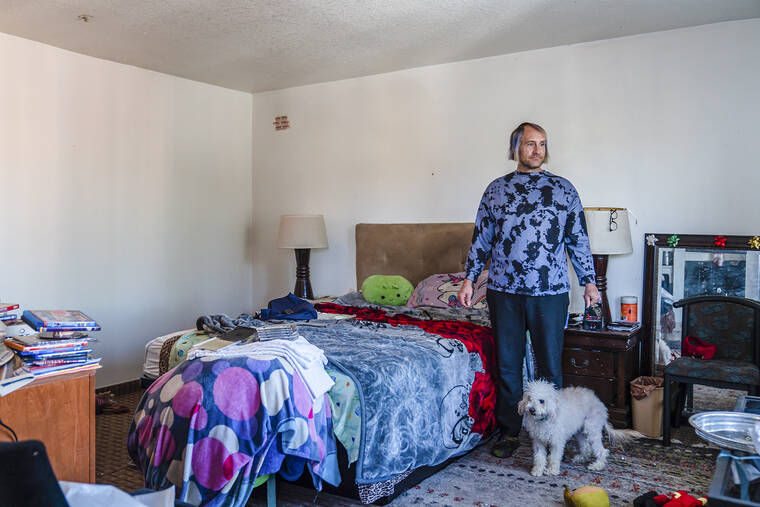How Los Angeles is trying to keep homeless people off the streets


LOS ANGELES — The day was shaping up to be another long one for Freddy Bauer.
He ambled down the stuccoed outdoor hallways of the Hotel Silver Lake, sidestepping the occasional mound of trash, to knock on doors in late August. Bauer, a case manager, was attending to dozens of people who used to live in the neighborhood’s most persistent homeless encampments in Los Angeles.
ADVERTISING
Already, a stream of residents had popped into the dimly lit office where Bauer worked: Had the mail come yet? Was there extra dog food?
There were forms to fill out and appointments to arrange. Then there was the conversation that Bauer had been dreading for days: telling one resident who had lived there for months that he would have to move out. The man had tampered with locks and broken rules barring visitors a few times too many.
City leaders, led by Mayor Karen Bass, have touted their recent success in cleaning up encampments and moving people indoors. But that progress hinges on the work of Bauer and hundreds of case managers like him. Their efforts, largely unseen, include finding shelter for people sleeping outside, then trying to keep them from teetering back over the edge. The work is slow and difficult.
It is enough to make someone wonder why Bauer, 31, who has a boyish face and a gentle demeanor, quit a better-paying job at Starbucks more than a year ago. But he says the intangible rewards make it worthwhile. It can feel miraculous when a homeless Angeleno finally moves into their own apartment.
‘This is hard’
When Bass took office almost two years ago, she emphasized that it was imperative to clear encampments without dehumanizing the people living in them.
Her signature program, Inside Safe, moves people from the streets into motels like Hotel Silver Lake, with the hope that they eventually find a long-term home. She has pointed to the decrease in the city’s homeless population this year — the first in six years — as evidence that her approach is working.
But other elected officials in California, responding to frustrated voters, have grown impatient. Gov. Gavin Newsom urged local officials this summer to more aggressively clear encampments after the Supreme Court ruled that cities could arrest homeless people for sleeping in public. Conservatives have accused nonprofit agencies of being ineffectual and part of a “homeless industrial complex” that has no financial incentive to solve the problem.
Caught in the midst of it all are the case managers.
The Hotel Silver Lake is perched on a hillside overlooking a chaotic intersection between the gentrified Silver Lake neighborhood and the urban enclave of Koreatown. From the motel rooms are views of the Hollywood sign and Griffith Observatory, tucked into the Santa Monica Mountains.
The property catered to tourists when it opened in 1959 as the Starlite Motor Hotel, complete with a Hawaiian luau celebration. Over the decades, it eventually became the kind of place where low-budget travelers stayed alongside homeless families who had scraped together money for a night indoors. Last year, the owners agreed to rent most of the rooms to the city to accommodate 55 homeless people.
The goal for case workers is to help them access their government benefits, get the health care they need and, ultimately, find permanent housing. Many who have lived on the streets for years have lost Social Security cards, birth certificates and other crucial documents that would help them restart their lives.
“I try to make sure my team knows that we’ve got to have compassion with everyone and understand that this is hard,” said Stella Fonseca, 28, who manages the program at Hotel Silver Lake through PATH, one of California’s biggest homelessness nonprofits.
At the same time, she said, she tells case workers and their clients that they should move with urgency: Politicians get replaced, funding streams shift. Inside Safe could be dismantled at any time.
Fonseca graduated with a master’s degree in social work from the University of Southern California. She is paid about $60,000 annually, while Bauer makes about $50,000 a year. In Los Angeles, where the median rent for a one-bedroom apartment is $2,195, according to Zillow, case managers do not make enough to comfortably afford housing on their own. Many have experienced periods of homelessness themselves.
Case workers help each client fill out applications for apartments, mental health care appointments, housing vouchers and identification cards. They submit the forms and follow up with government agencies by phone, text, email and sometimes in person. Bauer said he frequently accompanies clients to the Department of Motor Vehicles or other government offices.
In a motel room that had been converted into an office, Bauer tinkered with an enormous spreadsheet that tracks whether each resident has been verified as homeless by the government, whether they have identification documents, whether they have disability benefits and where they are in the search for a permanent home. Case workers typically have more than 20 clients each.
Just locating a vacant apartment is not enough. Bauer works with individuals who have been homeless for years and have severe mental health needs. They need housing that comes with extra support to ensure that residents do not slip back into homelessness.
But, like all housing in Los Angeles, such units are scarce and have long waitlists. Securing a home often involves a roller-coaster ride of hopes and disappointment.
The success of Inside Safe will be defined by how many people stay off the streets for good. So far, 741 of the 3,254 people who have moved out of homeless camps through the program have found a long-term place to live, according to the city.
That means that more than three-quarters of Inside Safe participants have not found permanent homes. And the cost of renting short-term rooms like those at the Hotel Silver Lake was estimated at $110 million last fiscal year, a price tag that is unsustainable in the long run.
Moving day
The first clients moved into the Hotel Silver Lake more than a year ago. Some were so unaccustomed to sleeping indoors that they pitched tents on their beds. They have slowly become used to locked doors at night and hot meals in the morning.
And in recent months, a couple dozen have finally gotten the keys to places of their own, their tickets out of limbo.
Robert Bean, 48, has been homeless off and on since he arrived in California as a 15-year-old from Oklahoma and Texas. He was living in an encampment until he moved into the Hotel Silver Lake in March 2023.
“For a long time, I handled it pretty well,” he said, sitting at a small table in his motel room. “The last five years, I caught myself starting to get angrier — angrier and angrier.”
Bean, mild-mannered, with pastel orchid-colored hair that he tucks behind his ears, said he was grateful for the help he received at the Hotel Silver Lake. The staff there helped him get mental health treatment and now, at last, his own apartment.
Bauer found a spot for Bean at a recently refurbished midrise building in Koreatown. The building has 64 units of low-income housing, including some for tenants who were recently homeless and need more support.
At the new building, Bean smiled faintly as he clicked through his lease on a tablet. He practiced using his electric key fob to check out one of the building’s two rooftop lounges, where he surveyed the neighborhood below.
Bauer beamed like a parent dropping his child off at the dorms. He and Bean sparred at a Foosball table in a resident lounge. He pointed out desktop computers available for Bean to use for the Los Angeles City College classes he planned to take.
Afterward, Bauer walked back to a van they had used to move Bean’s belongings and headed back to the Hotel Silver Lake.
There were phone calls to make, emails to send, doors to knock. Dozens of people were still living at the motel, and Bauer knew that they were waiting for their own turns to leave.
This article originally appeared in The New York Times.
© 2024 The New York Times Company






